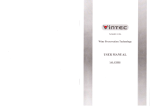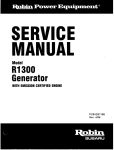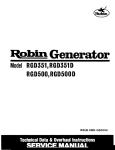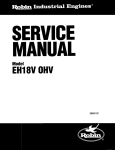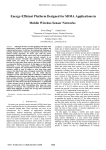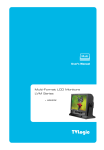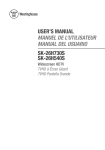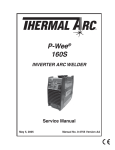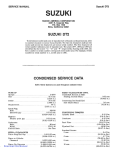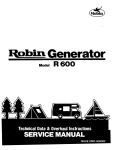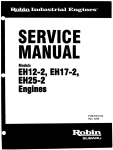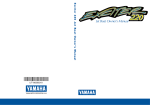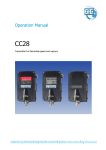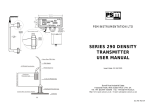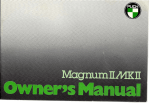Download R650 GENERATOR SERVICE MANUAL
Transcript
Generator TechnicalData& OverhaulInstructions SERVICE MANUAL CONTENTS Title Section 1. SPECIFICATIONS 2. PERFORMANCE 2-1 2-2 AC Output DC Output Page 1 ....................................... CURVES ................................ 2 ........................................ ........................................ 2 2 3 3. FEATURES ............................................ 4- 1 4-2 AND FUNCTION OF THE GENERATOR Construction ...................................... ......................... Function of Each Component Description of Generator Operation ..................... Electronic Ignition System ............................ 6. SAFETY PRECAUTIONS 7. AC Output DC Output 8. MEASURING 8-1 8-2 8-3 8-4 9-1 9-2 9-3 9-4 9-5 9-6 9-7 10-1 10-2 10-3 10-4 10-5 10-6 a. ............ ............................... Measuring Instruments ............................... Measuring AC Output ............................... Measuring DC Output Measuring Insulation Resistance ........................ MEMBERS ...................... Control Panel ...................................... Stator ............................................ Rotor ............................................ Ignition Coil ....................................... ........................................ Condenser .................................... Diode Rectifier. ...................................... Micro-Switch 10. DISASSEMBLY AND ASSEMBLY 8 8 9 12 14 16 18 ........................................ ........................................ 9. CHECKING FUNCTIONAL ..... 16 .............................. PROCEDURES ................ 7 15 ................................. RANGE OF APPLICATIONS 7-1 7-2 4 ............................ Component Identification Location of Serial Number, Specification and Specification Number. ............................... 5. CONSTRUCTION 5-1 5-2 5-3 5-4 4 ............ 4. GENERAL DESCRIPTION OF THE GENERATOR .......................... Preparation and Precautions ........................... Special Tools for Disassembly and Assembly .............. Disassembly Sequence ............................... Assembly Procedure ................................. ........................................ Carburetor Frequency Changeover System ......................... 20 20 22 22 22 24 24 26 28 29 29 29 30 31 31 31 32 47 58 61 Title Section Page 11. TROUBLESHOOTING . . . . . . . . . . . . . . . . . . . . . . . . . . . . . . . . . . . 63 1 1 - 1 Engine does not start or engine does not run normally. 11-2 Voltmeter does not work or pilot lamp does not turn No AC output . . . . . . . . . . . . . . . . . . . . . . . . . . . . . 11-3 No DC output .............................. 11-4 0utput voltage is normal at no-load, but generator won’t work on-load. . . . . . . . . . . . . . 12. CIRCUIT DIAGRAMS 12-1 12-2 50Hz/GOHz 60Hz-120V . . . . . . 63 on. . . . . . . . 66 . . . . . . . 69 . . . . . . . 69 . . . . . . . . . . . . . . . . . . . . . . . . . . . . . . . . . . . 71 Variable Type . . . . . . . . . . . . . . . . . . . . . . . . . . . . 71 Type . . . . . . . . . . . . . . . . . . . . . . . . . . . . . . . . . . 71 1. SPECIFICATIONS ENGINE I I 1 I Type Fuel tank capacity Oil pan capacity GENERATOR : Ignition system Starting system 1 I I I Solid state ignition Recoil starter Approx. Approx. Type I 2-pole revolving y regulating aximum output Rated output AC frequency AC voltage I 1 I I I I I AC receptacle 1 I field type Self-exciting Condenser type 55OW/65OW 650W 45ow/55ow 550w 50Hz/60Hz 60Hz 110,220,24OV 12ov (8.3A) Standard: 2 ea. (Special: 1 ea.) A couple DC terminal Over current protection 4.5 hours (50Hz) 4.0 hours (60Hz) 12V-1OOW DC output Dimensions 350 cc (0.75 U.S. pints) ( system side valve, 2 lit. (0.53 U.S. gal.) Rated continuous operating hours Exciting &troke, 78 cc (4.76 cu. in.) Displacement , Forced air-cooled, gasoline engine 1 I Circuit Voltmeter Standard Pilot lamp Standard breaker 370 x 265 x 345 mm (14.6 x 10.4 x 13.6 in.) (L x W x H) 18.5 kg (40.7 Ibs.) Dry weight -1- 2. PERFORMANCE CURVES 2-l AC OUTPUT w HZ 62 > 2 iW aI LL 5 “c I 2 61 60 59 HZ 600 ’ 600 51 500 4 w 50 49 400 LL 52 ; a v 300 W > a !i 2t W i 62 500 61 60 59 400 300 t ‘200 z 100 5 0 v 240 230 200 w 220 210 100 z 5 130 120 110 2 I 0 0.5 1.5 1 2 - CURRENT . 50Hz/60He220V n ” 2.5 0 1 CURRENT A Type OUTPUT Max. . . . 550W/50Hz, Rated . . 450W/50Hz, 2 l 3 4 5 - 6” A 60 Hz- 12OV Type OUTPUT Max. . . . . . . . . . . . . . . .65OW Rated . . . . . . . . . . . . . .55OW 650W/60Hz 550W/60Hz 2-2 DC OUTPUT 18 16 14 12 10 a 0 1 2 3 4 CURRENT 5 - 6 7 8 A -2- 9 10 12V Rated voltage ............. Rated current ............ 8.3A Rated output ............ 1OOW 3. FEATURES l Exhaust Fan Cooling System for low body temperatures, low noise, longer engine life and reliable performance. 0 Large 78 cc 4-Stroke Engine provides enough power for constant 55OW(at 60 Hz) rated output. 0 Simple One-Touch Engine Control Switch with the engine and fuel on/off levers and choke all integrated into one switch. 0 Easy and Reliable Starting with pointless ignition. This generator is also a brush-less type generator for maintenance-free operation. l Simple Design for a clean appearanceand easy maintenance. 0 Compact and Lightweight with an easy one-hand carrying handle grip. This generator also offers a high power-to-weight ratio and economical operation. 0 Circuit Breaker Protection for safe operation. Replacement of fuses is not necessaryin caseof an overload. 0 Unique Dual Output Design so that two separate A.C. and D.C. electrical appliances can be used at the same time. 0 Frequency Changeover Switch enableschanging output frequency from 50 Hz to 60 Hz. 0 Optional Oil Warning System automatically stops the engine if the oil level drops below the lower limit. (Factory Option) 0 Resistor Spark Plug is used as standard to prevent radio frequency noise. 0 Standard Tools are attached in the baseplate for easy maintenance. 0 AC Voltmeter is a standard equipment for monitoring output voltage. -3- 4. GENERAL DESCRIPTION OF THE GENERATOR 4-1 COMPONENT IDENTIFICATION HANDLE MUFFLER COVER AIR CLEANER MUFFLER AIR CLEANER Fig. 4- 1 FUEL TANK GENERATOR ENGINE Fig. 4-2 COVER MUFFLER RECOIL STARTER Fig. 4-3 FREQUENCY ADJUSTING (60Hz:120V TYPE1 UNIT FREQUENCY l50Hz~60Hz Fig. 4-4 -5- CHANGEOVER UNIT VARIABLE TYPEI COVER FRONT RECOIL HOUSING STARTER CARBURETOR Fig. 4-5 RUBBER PIPE (FOR AIR VENT) :E WIRE BASE PLATE Fig. 4-6 -6- 4-2 LOCATION OF SERIAL NUMBER, SPECIFICATION SPECIFICATION NUMBER AND The serial number is stamped on the crankcaseat the opposite side of the carburetor and also stamped on the label stuck above the oil filler cap. The specification and specification number are shown on the nameplate located on the rear cover. Always specify these numbers when inquiring about the generator or ordering parts in order to get correct parts and accurate service. SPECIFICATION SPECIFICATION NI SERIAL NUMBER Fig. 4-7 -7- 5. CONSTRUCTION 5-l AND FUNCTION OF THE GENERATOR CONSTRUCTION FUEI TANK - SPARK THROUGH RECOIL BOLT STARTER PLUG CYLINDER CRANKCASE \ I R n_ \ iI ~!ll::iill:!;ill:;il!l, , CRANKSHAFT BALL BEARING ’ FIELD FIELD CORE STATOR CO IL \ ’ COlL \ STATOR CORE Fig. 5- 1 -8- COOLING FAN VIBRATION ISOLATOR 5-2 5-2-l FUNCTION OF EACH COMPONENT GENERATOR REAR HOUSING 4 . STATOR (1) STATOR The stator consists of a laminated silicon steel sheet core, a main coil and condenser coil which are wound in the core slots. AC and DC output are taken out from the main coil. (DC output is taken out from the part of main coil which is in the middle of the main coil.) The condenser coil excites the stator field coil which generatesAC output in the main coil. Fig. 5-2 (2) CONDENSER The condenser is mounted on the rear housing and is connected to the condenser coil which is wound in the stator. The condenser coil magnetizes the rotor which increasesthe density of magnetic flux. (3) RECTIFICER The rectifier is also mounted on the rear housing and it converts AC current output from the main coil to DC current. The DC output from the diode of this rectifier is connected to the DC terminal. (4) ROTOR The rotor consists of a lamination silicon steel sheet core and field coil which is wound over the core. DC current in the filed coil magnetizes the steel sheet core. Two permanent magnets are provided at 90 degrees from the poles for the primary exciting action. A securely mounted fan is pressure-fitted on the end of the rotor shaft to cool the individual coils, iron cores, rectifier, and other integral parts. Cooling air from the fan is drawn in from the ventilation vents in the rear housing, and is discharged from the exhaust port in the front housing. s I Fig. 5-3 (5) CONTROL PANEL The panel on the front of the housing has a receptacle with a ground terminal and AC output is taken out with a male plug. DC output is taken out from the red (positive: +> and black (negative, -) terminals. Control switch, circuit breaker, voltmeter and pilot lamp are installed on the control panel. Fig. 5-4 -9- 5-2-2 (1) ENGINE CYLINDER and CRANKCASE The cylinder and the crankcase of the engine are of a one-piece aluminum die-cast design. The cast iron cylinder liner is molded inside the cylinder. Both the intake and exhaust ports are positioned at the lateral side of the cylinder and these parts are formed by using a mold with die-cast cores. The crankcase has its joint face located on the generator side. (2) MAIN BEARING COVER The main bearing cover is aluminum die-cast and is mounted on the generator side. By removing the main bearing cover, the interior of the engine can be inspected. (3) CRANKSHAFT The crankshaft is constructed of forged carbon steel. The crankpin is induction-hardened and has a pressfitted crank gear located on the generator side of the engine. (4) CONNECTING ROD and PISTON The connecting rod is constructed of forged aluminum alloy with both the large and small ends utilized as bearings. The oil scraper and large end cap are molded together. The aluminum alloy casting piston has two compression rings and one oil ring. (5) CAMSHAFT The camshaft is constructed of special cast iron and has intake and exhaust valve drive cams, each of which engageswith the cam gear. An exclusive aluminum alloy is used on each end of the camshaft in the place of bearings. (6) VALVE ARRANGEMENT The intake valve is installed at the oil port side and the exhaust valve at the generator side. (7) CYLINDER HEAD The cylinder head is die-cast aluminum and has Ricardo type combustion chamber featuring greater volume capacity for improved combustion efficiency. For easier spark plug maintenance, the cylinder head is positioned at an angle to allow greater access. (8) GOVERNOR The centrifugal weight type governor ensures constant engine speed, regardless of load fluctuations (the governor is mechanically linked to the governor drive gear). (9) EXHAUST FAN COOLING SYSTEM (See Fig. 5-5.) Instead of blowing outside air on the engine, the Exhaust Fan Cooling System of this generator intakes the cool air and forces the hot air outside from one outlet. This keeps the body temperature lower for greater safety and extends service life. (10) LUBRICATION SYSTEM The moving and sliding parts inside the engine are lubricated with the oil scraper fitted on the connecting rod. As the crankshaft rotates, the connecting rod moves up and down and the oil scraper moves in conjunction with the connecting rod movements to scrape up oil in the crankcaseand splash it over the surfaces of the moving and sliding parts. -10- (11) IGNITION A flywheel/magneto igntion system is employed with the ignition timing set at 23” before top dead center. The magneto is composed of the flywheel and ignition coil with the flywheel mounted on the rotor shaft. The ignition coil is fitted to the front housing. (12) CARBURETOR The horizontal draft type carburetor is installed so that the engine will provide excellent starting, good acceleration, low fuel consumption, and superior output. [For details concerning carburetor construction, see the paragraph dealing with carburetor construction and disassembly/assembly(Page 59).] (13) AIR CLEANER The air cleaner is a semi-wet type and contains a sponge element. Fig. 5-5 -11- 5-3 DESCRIPTION OF GENERATOR INITIAL EXCITATION PERMANENT MAGNETO FIELD OPERATION STATOR COIL ROTOR ------DIODE CONDENSER L ------ COIL A Fig. 5-6 5-3-l GENERATION OF NO-LOAD VOLTAGE 1) When the generator starts turning the permanent magneto built-in to the flywheel, it generates 1 to 4V of AC voltage in the main coil and condenser coil. 2) The condenser coil is connected to a condenser. So. when a voltage is generated in the condenser coil, minimum current @ flows in the condenser coil. At this time, small flux is produced, with which the magnetic force of the rotor’s magnetic pole is intensified. When this magnetic force is intensified, the respective voltages in the main coil and condenser coil rise. Current @ flowing in the condenser coil increases, with the magnetic flux density of the rotor’s magnetic pole increasing further. Also, the main coil voltage and condenser coil voltage increases.These voltage continue rising as this process is repeated. 3) As current flows in the condenser coil, the magnetic flux density in the rotor changes.AC voltage is in- duced in the field coil when the magnetic flux density varies. Successively,AC current is rectified by the rectifiers connected to both ends of the field coil, and DC current @ flows in the field coil. With this current, the rotor core is magnetized, allowing the generator to output steady voltage. 4) When generator speed reaches 2000 to 2300 rpm (50 Hz specification) or 3000 to 3300 rpm (60 Hz specification), the current in the condenser coil and field coil increasesrapidly. This acts to stabilize the respective coil output voltages. If generator speed further rises to the rated value, the generator output voltage will reach the rated value. 5-3-2 VOLTAGE FLUCTUATIONS UNDER LOAD When load current @ flows from the generator to the electrical equipment, the magnetic flux which is produced as current @ flows in the main coil, this flux servesto increase current @ flowing in the condenser coil. With current @ increased, the magnetic flux density across the rotor core rises. As a result, the current flowing in the field coil increases,and the generator output voltage is prevented from decreasing. -12- 5-3-3 DC OUTPUT DC output is taken out from the main coil and is fed to the diode at which time the output undergoes full-wave rectification prior to being supplied to the load connnected to the generator. The diode rectifier works to allow the current to flow in @ direction but does not allow the current to flow in @ direction as shown in Fig. 5-7. Fig. 5-8 shows the DC output circuit of the generator. DC voltage is generated in the main coil; when the voltage in A is higher than that in C, current @ flows in the direction shown in the figure while no current flows between C and B because current is cut off by the diode D2. Contrary to the aforementioned, if the voltage in C is higher than that in A, current @ flows in the direction as shown in the figure, with no current flowing between A and B. This is because the diode Dl cuts off the current between A and B. As a result, voltage generated between the DC terminals has a waveform with two peaks in one cycle, as in the caseof the output waveform with two peaks in one cycle, as in the caseof the output waveform shown in Fig. 5-9. Fig. 5-7 Dl RY MAIN COIL B Fig. 5-8 BETWEEN A AND B OUTPUT BETWEEN C AND WAVEFORM B BETWEEN AAND B Fig. 5-9 -13- + A BETWEEN CAND B 5-4 ELECTRONIC IGNITION SYSTEM The electronic ignition system features a power transistor as the current control element. Therefore, the ignition system is an electronic contact point-free type that operates with the power transistor impulses controlling the current. This system is also called TIC (transistor igniter circuit) and is virtually free of ignition failure which generally results from contamination of the contact points, a typical problem with contact type ignition systems. Because this ignition system has no contact points, it is not affected by moisture, oil, dust, or other contaminants. As a result, this electronic ignition system ensuressure and positive ignition with reduced maintenance. The TIC mechanism consists of a transistor-incorporated ignition coil and a permanent magneto built-in flywheel which is press-fitted on the rotor shaft of the generator. I IGNITION IGNITION TIMING DETECTING CIRCUIT COIL SPARK PLUG Fig. 5- 70 (1) When the permanenet magneto built-in flywheel starts rotating, power is generated in the primary coil of of the ignition coil and current flows to the resistor @ . From the resistor, current flows to the power transistor. With this current, the power transistor turns on, releasing current @ . This stage corresponds to the closing of contact points. (2) As the flywheel comes to the point of ignition, the ignition timing detecting circuit is activated while the current @ is flowing through the circuit. When the ignition timing detecting circuit is activated, the signal transmitter transistor actuates with current d flowing. When current @ starts flowing, current @ flowing through the power transistor is cut quickly. As a result, high voltage is produced in the secondary coil and this voltage is applied simultaneously to the spark plug which ignites for ignition. This stage corresponds to the opening of contact points. -14- 6. SAFETY PRECAUTIONS 1. Use extreme caution near gasoline. A constant danger of explosion or fire exists. Do not fill the fuel tank with gasoline while the engine is running. Do not smoke or use open flame near the fuel tank. Be careful not to spill fuel when refueling. If spilt, wipe it and let it dry before starting the engine. 2. Do not place inflammable materials near the generator. 0 Be careful not to put gasoline, matches, gunpowder, oil cloth, straw, trash and any other inflammables near the generator. l Operate the generator at least 1 meter (4 feet) away from a building or wall. 3. Do not operate the generator in a room, cave or tunnel. Always operate in a well-ventilated area. Otherwise the engine may become overheated and also, the poisonous carbon monoxide contained in the exhaust gaseswill endanger human lives. Keep the generator at least 1 m (4 feet) away from structures or facilities during use, and always operate it with the exhaust pipe directed toward the open-air or where good ventilation is assured. 4. Operate the generator on a level surface. l Do not operate the generator on a inclined surface. l Do not move or carry the generator while it is running. 5. Do not operate with wet hands or in the rain. Severe electric shock may occur. If the generator is moistened by rain or snow, wipe it and fully dry it before starting. l Do not pour water over the generator directly nor wash it with water. If the generator is wet with water, the insulations will be adversely affected and may causecurrent le.akage and electric shock. 6. Do not connect the generator to the residential power source. This could result in a malfunction of, or damge to the generator or appliance to which it is connected or could even lead to fire. 7. Do not cover the generator with a carton, a box or other cover while it is running. -15- 7. RANGE OF APPLICATIONS 7-1 AC OUTPUT Generally, the rated power of an electrical appliance often refers to the amount of work that can be done by it. The electric power required for operating an electrical appliance is not always equal to the amount of work that can be done by it. Electrical appliances generally have a label showing their rated voltage: frequency, and power consumption (input power). The power consumption of an electrical appliance is the power necessary for using it. When using a generator for operating an electrical appliance, however, the power factor and starting current must also be taken into consideration. Determine the capacity of your generator from the power required for operating electrical appliances referring to the followsing: (1) Incandescent lamps, hot plates, etc. with a power factor 1.O Total power consumption must be equal to or lessthan the rated output of generator. Example: A generator with a rated output power of 500W can light five 1OOWlamps. (2) Fluorescent lamps, mercury lamps, etc. with a smaller power factor Select a generator with a rated output equivalent to 1.2 to 2 times the power consumption of the load. Example: A generator with a capacity of 1OOWto 16OWis necessaryfor lighting a 8OWfluorescent lamp. A generator with a rated output of 5OOWcan light three to five 40W fluorescent lamps. NOTE: Wattage of the fluorescent lamp generally does not indicate the power consumption but indicates the output of the lamp. Therefore, if the fluorescent lamp has no special indication as to the power consumption of input power, efficiency should be taken into accounts as explained in Itern 5 on the following page. (3) Electric tools, etc. that are driven by a motor 1.2 to 3 times large power consumption of a motor-driven tool is required for starting. Select a generator with a maximum output 1.2 to 3 times large to the load. Example: A 300W motor-driven drill requires a generator with a maximum output of 400 to 9OOWor more. (4) Water pumps, compressors, etc. that are driven by a motor and are initially loaded 3 to 5 times large power is necessary for starting. Select a generator with 3 to 5 times large output of load. Example: A water pump with a power consumption of 400W requires a generator with a maximum output of 1200 to 2000W or more. NOTE 1: Motor-driven appliances mentioned in Items 3 and 4 required the aforementioned generator capacities only when starting their mo tars. Once their motors are started, the appliances consume about 1.2 to 2 times their rated power consumption so that the excess power generated by the generator can be used for other electrical appliances. NOTE 2: Motor-driven appliances mentioned in Items 3 and 4 vary in their required motor starting power depending on the kind of motor and start-up load. If it is difficult to determine the optimum generator capacity, select a generator with a larger capacity. - 16- (5) Appliances without any indication as to power consumption Some appliances have no indication as to power consumption; but instead the work load (output) is indicated. In such a case, power consumption is to be worked out according to the numerical formula mentioned below. (Output of electkd amfiance) = (Power consumption) (Efficiency) Efficiencies of some electrical appliances are as follows: Single-phasemotor . . . . . . . . . . . . . . . 0.6 - 0.75 Three-phase motor . . . . . . . . . . . . . . . 0.65 - 0.9 t Fluorescent lamp . . . . . . . . . . . . . . . . 0.7 - 0.8 The smaller the motor, the lower the efficiency. Example 1: A 40W fluorescent lamp means that its luminous output is 40W. Its efficiency is 0.7 and accordingly, power consumption will be 40 + 0.7 = 57W. As explained in Item 2, multiply this power consumption value of 57W by 1.2 - 2 and you will get the figure of the necessary capacity of a generator. In other words, a generator with a rated output of 500W capacity can light four to seven40W fluorescent lamps. Example 2: Generally speaking, a 400W motor means that its work load is 400W. Efficiency of this motor is 0.7 and power consumption will be 400 t 0.7 = 570W. When this motor is used for a motor-driven tool, the capacity of the generator should be multipled by 1.2 to 3 and 570W as explained in the Item 3. RANGE ELECTRIC OF APPLICABLE LOADS DEVICES 50 Hz 60 Hz Incandescent lamp, electric heater, etc. up to 450w up to 550w Fluorescent Up to approx. 350W Up to approx. 450W Up to approx. 350W Up to approx. 400W Up to approx. 15OW Up to approx. 18OW Motor-driven lamp, mercury lamp, etc. tools etc. Pump and compressor drive motors I Table 7- 7 NOTES: Wiring between generator and electrical appliances 1. Allowable current of cable Use a cable with an allowable current that is higher than the rated input current of the load (electrical appliance). If the input current is higher than the allowable current of the cable used, the cable will become excessively heated and deteriorate the insulation, possibly buring it out. Table 7- 2 she ws cables and their allowable current for your reference. 2. Cable length If a long cable is used, a voltage drop occurs due to the increased resistance in the conductors so that the input voltage to the load (electrical product) decreases. As a result, the load can be damaged. Trable 7-2 shows voltage drops per 100 meters of cable. - 17- Nominal cross Table 7-2 Voltage decreaseindicates as V = -&- xRxIx!J R means resistance (a! 100 m) on the above table. I means electric current through the wire (A). Q means the length of the wire (m). The length of the wire indicates round length, it means twice the length from generator to electrical tools. 7-2 DC OUTPUT When the generator is employed to recharge batteries, care must be exercised about the specific gravity of electrolyte in each battery case. 7-2-l MEASURING THE SPECIFIC GRAVITY OF ELECTROLYTE: The specific gravity changeswith temperature; therefore, it is converted to another, corresponding to 20°C. s20 = St + 0.0007 (t - 20) s20 = Specific gravity corresponding to 20°C = Measured value = Temperature at time of measurement where St t 7-2-2 REMAINING CAPACITY ELECTROLYTE: SPECIFIC GRAVITY (20°C) ESTIMATED WITH REFERENCE TO THE SPECIFIC GRAVITY OF REMAINING BATTERY (%I 1.260 100 1.240 87 1.220 75 1.200 62 1.180 50 1.160 37 1.140 25 REMARKS Good charged condition Charging is necessary. Immediate charging is necessary. , Table 7-3 - 18- 7-2-3 BATTERY CAPACITY The battery capacity is expressed in units of ampere-hour (AH). One AH stands for the capacity capable of providing one ampere of current for one hour. 7-2-4 SIMULTANEOUS USE OF THE AC/DC OUTPUT If you use the AC/DC output simultaneously in this generator, be careful not to exceed the total power consumption. 50Hz 60 Hz NOTE: Max. output below 250W below 350W of DC is lOOW (12V x 8.3A). -19- 8-1 MEASURING INSTRUMENTS 8-l -1 VOLTMETER AC voltmeter is necessary.The approximate AC voltage ranges of the voltmeters to be used for various types of generators are as follows: oto150v 0 to 3oov : Type with an output voltage of 11OV or 12OV : Type with an output voltage of 22OV, 230V or 24OV FOR AC Fig. 8- 1 8-l-2 AMMETERS AC ammeter is necessary. An AC ammeter with a range that can be changed according to the current rating of a given generator is most desirable. (About 1OA, 20A, 1OOA) I Prepare a DC ammeter which has a scale range of 15A. Fig. 8-2 8-l-3 FREQUENCY METER Frequency range: About 45 to 65 Hz. NOTE: Be careful of the frequency voltage range. meter’s input Fig. 8-3 - 20 - 8-1-4 CIRCUIT TESTER Used for measuring resistance, etc. Fig. 8-4 8-l-5 MEGGER METER Used for measuring generator insulation resistance. Select one with testing voltage range of 5OOV. 1 J Fig. 8-5 8-1-6 TACHOMETER Use a contact-less type tachometer. CONTACTLESS TYPE Fig. 8-6 -21- 8-2 MEASURING AC OUTPUT TO A Fig. 8-7 With the circuit shown in Fig. 8-7 , measurment is made of the AC output of the generator. An electric heater or an incandescent lamp with a power factor of 1.O is suitable as a load for the generator. When the measured AC output of the generator is confirmed to be within the voltage range specified in the table below, over its voltage rating, the AC output is normal. Measurement must be made under rated load and at rated speed; sometimes, load and speed adjustments are necessary. Voltage rating Range of voltage 11ov 12ov 104 - 107v 114- 127V 220v 240v 211 N 234V 227 - 253V Table 8- 1 8-3 MEASURING DC OUTPUT SWITCH @ @ DC TERMINAL Fig. 8-8 Measurement is made of the DC output of the generator with the switch shown in the above circuit turned on while the generator is kept running at its rated speed. The DC output should be within 11 to 14 with the current regulated at 8.3A by adjusting the load connected to the generator. NOTE: If a battery is connected as a load to the generator, the DC output voltage will increase by approximately 1 to 2V. Therefore, carefully observe the electrolyte level and do not overcharge the battery. 8-4 MEASURING INSULATION RESISTA ,NCE To measure insulation resistance, connect the megger tester across either one of the two output terminals of the socket and the earth terminal. When the measured insulation resistance of the generator is over 1 Mfi2, it is normal (over lOM!2 at time of shipment). (Be sure to turn on the circuit breaker when measuring insulation resistance.) If the insulation resistance is less than lMS2, disassemble the generator, and measure the respective resistancesof the stator, rotor and control panel. Fig. 8-9 -22 - 8-4- 1 STATOR Measure the insulation resistance between the RED lead and the core. The resistanceshould be larger than 1 Ma. If the resistance is less than 1 Ma, the insulation is failed. Replace the stator with a new one. Fig. 8- 10 8-4-Z ROTOR Measure the insulation resistance across one of the soldered terminals of the rotor and the core. The resistance should be larger than 1 MS2. If the resistance is less than 1 MSZ, the insulation is failed. Replace the rotor with a new one. F& 8-17 8-4-3 CONTROL PANEL Measure the insulation resistance between the live parts and the grounded part. If the measured resistance of a component is below 1 MS2,the insulation is defective. Promptly replace the defective component because there may be leakage of current from the generator and a potential danger of electrical shock. Fig. 8- 12 - 23 - 9. CHECKING FUNCTIONAL 9-l CONTROL MEMBERS PANEL 9- I- 1 ENGINE SWITCH Using a circuit tester, check continuity across the black and green top terminals of the 6P coupler. When continuity between the terminals is confirmed with the engine switch turned off, the switch is normal. It is also normal if there is no continuity between these terminals, when the engine switch is set at RUN or CHOKE position. Fig. 9- 1 9-l-2 VOLTMETER Also check with the circuit tester, the continuity across the white and brown top terminals of the 6P coupler. If continuity is confirmed between these terminals, the voltmeter is normal. Fig. 9-2 9-1-3 PILOT LAMP Check the pilot lamp to be turned on by applying specified voltage. Pilot lamp cannot be checked with a circuit tester because it is a light emitting diode and its resistance is too large. - 24 - 9 - 1 - 4 AC RECEPTACLES Using a circuit tester, check continuity between the two terminals at the rear of the AC receptacles while the receptacle is mounted on the control panel. When continuity is confirmed between the output terminals of the receptacle with a wire connected across these terminals, the AC receptacle is normal. When the wire is removed and no continuity is confirmed between these terminals, the receptacles are also normal. J Fig. 9-3 (A) Fig. 9-3 (B) 9 - 1 - 5 DC TERMINALS Using a circuit tester, check continuity between the DC terminals at the rear side of the control panel while they are mounted on thepanel. When continuity is confirmed between the DC terminals with a wire connected across these terminals, the DC terminalsarenormal. When the wire is removed and no continuityis confirmed between these terminals, theterminals are also normal. Fig. 9 - 4 9 - 1 - 6 CIRCUIT BREAKER Check continuity between each of two terminals at the rear of the circuit breaker while it is mounted on the control panel. Normally, there is continuity between each of the two when the circuit breaker is on while there is no continuity when the circuit breaker is off. I [6P COUPLER WIRING] GREEN/YELLOW YELLOW RED BROWN WHITE Fig. 9-5 - 25 - 9-2 STATOR Measure the resitance of each stator coil using the circuit tester. 240V - 50160Hz 12.OQ 0.7R 8.1!iI 7.3i-l (at 21’C) Table 9- 7 NOTE: If the circuit tester is not sufficiently ous readings. [6P COUPLER accurate, it may not show the values given and may give errone- WIRING] GREEN/Y YELLOW ,BROWN RED t3P COUPLER ELLOW ,WHITE WIRING] BLUE LIGHT BLUE WHITE MAIN COIL CONDENSER - 26 - COIL AC COIL DC COIL / F/Q.9-7 f- CONDENSER COIL FOR 5OHz FOR 60Hz \ ORANdE , Fig. 9-8 - 27 - 9-3 ROTOR 1) Unsolder the diode and the resistor from the rotor terminal. Unsolder one wire of each part. E RECTIFIER Fig. 9-9 2) Check the resistance between the wire ends of rotor winding at the terminals. I I NORMAL RESISTANCE 11.5s2 I I ~~Fig. 9- 10 3) Check the diode. Touch the positive (RED) probe of the circuit tester to the cathode mark side of the diode, and touch the negative (BLACK) probe to the other side of the diode. Normal resistanceis 16a. Reverse the polarity of the circuit tester. At this time, the resistance is infinity. 1NORMAL RESlSTANCEj I 16S2 [RemeM If the diode is defectrive, replace with a new one. CATHODE Fig. 9-77 - 28 - MARK I 9-4 IGNITION COIL Using a circuit tester, measure the resistance of the ignition coil. RESISTANCE VALUE MEASUREMENT LOCATION Primary coil 0.61S2 Between the core and the green cord Secondary coil 7.5kR Between the green cord and the high-tension cord Table 9-2 9-5 CONDENSER If an instrument (QC-meter or C-meter) for measuring the capacity of a condenser is available, check the capacity of the condenser. n Usually the instrument is expensive and difficult to obtain, we suggest instead that you install a new condenser and seeif the generator works. If the generator works with a new condenser: the old one is defective. Fig. 9- 12 9-6 DIODE RECTIFIER Using a circuit tester, measure the resistancebetween each of the two terminals of the rectifier. The rectifier is considered normal when the respective resistanceshave the values specified below. RED The polarity WHITE GREEN of the circuit tester Fig. 9- 13 - 29 - 9-7 MICRO-SWITCH Check the micro-switch using a circuit tester. Pushed in out 00 0 0 Do BUTTON F&. 9- 14 - 30 - 10. DISASSEMBLY AND ASSEMBLY 10-l PREPARATION AND PRECAUTIONS 1) Be sure to remember the locations of individual parts when disassemblingthe generator so that the generator can be reassembledcorrectly. Tie tags noted with the necessaryinformation to facilitate easier and smoother reassembly. 2) For more convenience, divide the parts into severalgroups and store them in boxes. 3) To prevent bolts and nuts from being misplaced or installed incorrectly, place them temprorarily back at their original position. 4) Handle disassembledparts with care; clean them before reassembly using a neutral cleaning fluid. 5) Use all disassembly/assemblytools properly, and use the right tool for each specific job. 6) Dram fuel tank of fuel and crankcaseof oil before disassembly. 10-2 SPECIAL TOOLS FOR DISASSEMBLY AND ASSEMBLY 2 0 1 4 1 4 Fig. lo- 1 I I 1 2 3 I Valve spring retainer 230-95001-07 DESCRIPTION I For disassembling and deassembling the intake and exhaust valves I I I I I NAME OF TOOL TOOL NO. NO. 230-95002-07 Valve guide puller 358-95001-07 Rotor puller I Table 70-l -31- To pull out the valve guide 1 To pull out the rotor I 10-3 DISASSEMBLY step SEQUENCE Part to remove Description Precautions 1 Side cover (L) and (R) ’ (1) Remove both left and right cover by taking out eight MS flange screws. 2 Couplers (disconnection) 0+ Plus screw-driver (1) Disconnect the (6P) coupler of the generator from the other (6P) extending from the control panel. SIDE COVER Necessary tools Pull them downward while pressing down the retainer claws. (See Fig. 10-2.) IL) SIDE M5 FLANGE Fig. IO-2 - 32 - SCREW: 8 PCS. COVER (Ri r Step 3 Part to remove i Choke cable 4 Fuel line (1) Hold the fuel line clamp inserted inside the strainer using pliers, and pull it backward to remove the fuel line from inside the strainer. HOSE It Precautions , (1) Set the control switch to STOP and disconnect the choke cable from the lever. i (2) Disconnect the outer cable of the choke cable from the fuel tank bracket. , (3) Loosen the M4 screw of the carburetor choke lever swivel to pull out the inner wire from the choke cable. FUEL CHOKE Description HOSE (See Fig. 10-3.) 10 mm box spanner 0t Plus screw-driver Be careful not to damage the hose. 1 (See Fig. 10-4.) CHOKE CABLE CL -AMP CABLE -. Fig. 10-3 Necessary tools Fig. 10-4 Pliers Step 5 Fuel tank handle Necessary tools Precautions Description Part to remove (1) Push up the end of the cover fitted to the handle with finger. (2) Pull out the rubber tube used as the air vent pipe. (3) Remove two bolts (tank), and remove the handle. 10 mm box spanner 6 Rear cover (1) Remove the rear cover at the opposing side of the control panel by unscrewing the four M6 flange bolts. 10 mm box spanner 7 Fuel tank (1) Loosen the set screw of the strainer shaft at the rear of the engine control switch. (2) Remove two MS flange bolts clamping the front cover and tank bracket together, and then remove the fuel tank. 0t Plus screw-driver HANDLE COVER FUEL TANK (See Fig. 10-S.) REAR 10 mm box spanner COVER ‘\P,PE -/ a. M5 FLANGE BOLT: .. ; I Fig. 10-5 - 34 - 2 PCS. StepI 8 9 Part to remove Description Front cover (1) Remove two M5 flange bolts clamping the front cover to the base, and remove the front cover. Fuel hose 7==- 10 mm box spanner ti (1) Using pliers, hold the fuel line clamp at the fuel support joint of the carburetor (L-joint directed downward), and pull it aside. Then, pull out the line. Be careful not to damage the fuel line. Electrician’s pliers (1) Insert the tip of a screwdriver into the groove of the choke cable blacket and turn it to remove the choke cable. (See Fig. 10-7.) screw0 Minus driver CHOKE FR ONT Precautions CABLE COVER SE CLAMP M5 FLANGE Fig. 10-6 BOLT: 2 PCS. Fig. 10-7 StepI Necessery tools Description Precautions (1) Remove the outer cover; this is done by removing seven M5 tapping screws. (2) Remove one M6 x 12 flange bolt of the muffler bracket, and two M6 nuts from the muffler flange. Then, remove the flange. (3) Remove four MS x 8 lock screws from inside inside of the muffler and remove the inner cover. Take care not to drop the removed screws down into the cooling air channel. (See Fig. 10-8.) Part to remove I 11 12 Muffler cover and muffler Base plate t Plus screw-driver 0 10 mm box spanner Minus screwdriver 0 (1) Remove one set screw of the earth wire which grounds the rear housing and base plate together. (2) Remove four M5 x 10 bolts from the bottom of the base plate. 0 t Plus screw-driver 8 mm box spanner UFFLER COVER (INNER) LOCK SCREW: 4 PCS. SET SCREW EARTH WIRE kY a BOLT & WASHER: 4 PCS. M6 / FLANGE MUFFLER COVER BOLT I MUFFLER \ M5 TAPPING / BOLT Fig. 70-8 - 36 - SCREW: 7 PCS. Step Part to remove Description Precautions Necessary tools 13 Recoil starter (1) Remove the recoil starter from the rear housing by removing three M6 x 8 flange bolts. (See Fig. 10-9.) 10 mm box spanner 14 Starter pulley (1) Turn the starter pulley by hand to set the piston to the compression stroke top (where the pulley becomes heavy). Using a hammer, strike the box wrench set over the head of the through-bolt to remove the bolt. Then, remove the pulley. (See Fig. 10-10.) 12 mm box spanner RECOIL FLANGE BOLT: STARTER 3 PCS. Fig. 10-9 Fig. lo- 10 Step 15 M6 BOLT Part to remove Stator assembly & WASHER: 3 Description (1) Remove three M6 x 85 bolts clamping the rear housing of the stator assembly and the front housing together. Disconnect six wires from the micro switch on the speed control unit. (50Hz/60Hz variable type only) (2) Remove the stator assembly from the front housing. The stator and rear housing are removed together by using a plastic hammer to lightly strike the boss of the rear housing. (3) Remove both the capacitor and diode from the rear housing by remving two M5 x 10 screws. (4) Remove the wiring between the stator and rear housing. Disconconnect three wires from the diode, two wires from the capacitor and the ground wire from the rear housing. Precfhutions 10 mm box spanner Plastic hammer (See Fig. lo- 11.) pa. Fig. lo- 11 - 38 - Necessary tools @Plus screw-driver L I Step Part to remove Description Precautions l6 Rotor assembly (1) Insert a rotor-puller into the rotor shaft and tighten it until the rotor comes loose. 17 Spark plug cap (1) Remove the plug cap from the spark plug. (2) Remove the clamp of the hightension cord. - Rotor puller I 18 Front housing and center baffle FRONT I , (1) Remove the front housing and center baffle from the engine main bearing cover by removing three M6 x 25 mm bolts and one Ivl5 x 55 mm bolt. SPARK Necewary tools PLUG (See Fig. lo- 12.) CAP 10 mm box spanner FLANGE BOLT HOUSING HIGH-TENSION Fig. lo-72 CORD Step 19 Part to remove Air cleaner Description Precautions Necessery tools (1) Remove the center screw of the air cleaner cover to remove the cleaner cover, filter element, and element retainer. 1 (2) R emove the M5 screw at the lower right inside the element chamber. I ! (3) Remove two M6 nuts clamping the air cleaner and the carburetor together to remove the air cleaner. AIR CLEANER 0 0 Minus screwdriver t Plus screw-driver 10 mm box spanner CASE ELEMENT RETAINER AIR CLEANER I I CENTER - 40 - SCR-EW COVER Precautions Step Part to remove Description 20 Governor and related parts (1) Remove the governor lever from the governor shaft. Loosen the bolt (unnecessary to remove it). Necessary tools 10 mm box spanner (2) Remove the governor rod, rod spring, and governor spring. 21 Speed control unit (1) Remove the speed control unit from the crankcase. (1)’ Remove the voltage changeover unit from the crankcase. 22 Carburetor (1) Remove the carburetor from the crankcase. 10 mm box spanner CARBURETOR ROD BdLT SPRING & WASHER -41- I1 Precautions Description Part to remove Step Necessary tools 23 Head cover (1) Remove two MS screws from the lateral side of the head cover to remove the head cover. 0t Plus screw-driver 24 Cylinder baffle (1) Remove the MS screw from the main bearing cover to remove the cylinder baffle. 10 mm box spanner I 0t Plus screw-driver I I M5 SCREW :’ -42- & WASHER 4 Step Part to remove Description Precautions Necessary tools 25 Spark plug (1) Remove the spark plug from the cylinder head. 26 Cylinder head (1) Remove the sen M6 x 32 bolts to remove the cylinder head. (2) Remove the head gasket. Mark the head gasket with its mounting position accurately matching the cylinder head, also mark the gasket mounting face of the cylinder head. 10 mm box spanner 27 Intake valve and Exhaust valve (1) Remove both the inner and outer tappet chamber covers from the crankcase by removing two M6 x 12 bolts. (2) Remove both the intake and exhaust valves. (3) Remove the valve spring and retainer. Be sure to position the notch in the spring retain’ er’s outside periphery to the front and hook the minus screw-driver (medium size) in the recess (lower side) of the retainer. Then, pull the spring retainer backward to remove it. 10 mm box spanner SPARK PLUG 19 mm box spanner 0 Minus screwdriver 1 I PULL-BACK HEAD NTAKE VALVE ALVE SPRING GASKET ,yq -43- SPRING RETAINER TAPPET COVER 28 Main bearing cover Precautions Description Part to remove Step (1) Remove the Woodruff key from the crankshaft. (2) Remove five M6 x 25 bolts locking the main bearing cover from the crankcase. (3) Using a plastic hammer or a similar tool, strike the main bearing cover uniformly around its periphery to remove the cover. 10 mm box spanner Be careful not to damage the lip of the oil seal. 29 Camshaft (1) Pull out the camshaft from the crankcase. Set the crankcase sideways so that it will not fall and damage the tappets. 30 Tappets (1) Remove the tappets from the crankcase. Be sure to mark the tappets to distinguish them from each other; one for the intake vale and the other for exhaust valve. MAIN BEARING COVER Necessary tools Plastic hammer CAMSHAFT TAPPET M6 BbLT 61 WASHER: 5 pcs. -44 - Part to remove Step 31 32 Connecting rod and piston Piston and piston a3 PISTON Description Precautions (1) Scrape off the carbon deposits from the cylinder and piston head. Push and open the bend of the connecting rod lock washer, and remove two bolts. (2) Remove the lock washer and connetting rod cap from the crankshaft. (3) Turn the crankshaft until the piston comes to its top position, and push the piston from the upper part of the cylinder. Confirm the mounting direction of the oil scraper. (1) Remove two clips from the piston pm and take out the piston pin. Remove the piston from the connecting rod. (2) Each of the piston rings can be removed from the piston by opening wide the ring joint. (1) Replace these clips with new ones; do not reuse them. (2) Be careful not to damage the minor rod end. (3) Be careful not to open the ring joint excessively. RINGS.-& CLIP CONNECTING ROD’ ROD BOLT: LOCK ,k(dj WASHER / ‘.. 2 pc dlL SCRAPER -45- Necessary tools @Minus screwdriver Pliers 10 mm box spanner I Step I 33 ( 34 Description Part to remove Crankshaft / Governor shaft 11) Pull out the crankshaft from the crankcase. If unable to pull it out by hand, use a plastic hammer to gently strike the main bearing joint face, and pull the crankshaft out. 11) Remove the clip of the governor shaft, and pull out the governor shaft from the crankcase. CRANKCASE CRANKSHAFT GOVERNOR SHAFT -46- Precautions Necessary tools 10-4 ASSEMBLY 10-4-l PROCEDURE PRECAUTION IN ASSEMBLY (1) Thoroughly clean each part. When cleaning, take special care for the piston, cylinder, crankshaft, connecting rod, and bearing. (2) Be sure to completely remove the carbon deposits on the cylinder head and piston head. Also, thoroughly clean and remove carbon deposits from each piston ring groove. (3) Apply lubricating oil to the lip of each seal. Confirm that the lip of each oil seal is not damaged.If damaged, replace with a new one. (4) Replace the gasketsand similar items with new ones; do not reuse old gaskets. (5) Replace the keys, pins, bolts, nuts, etc. with new ones if necessary. (6) Do not apply torque exceeding the specified value. (7) Apply lubricating oil to both moving and sliding parts when they are assembled. (8) Prior to assembly, check the clearance of each part, and adjust it if necessary. (9) When each of the main components are assembled,turn it by hand to check for smoothness of rotation and unusual noise. 10-4-2 ASSEMBLY SEQUENCE AND PRECAUTIONS (1) GOVERNOR SHAFT Put the governor shaft into crankcase, then drive the clip into position to secure the governor shaft. (2) CRANKSHAFT a) Insert the crankshaft into the ball bearings of the crankcase. b) Fig. 1O-l 3 shows the dimentional tolerance of the crankpin. OUTSIDE DIAMETER I- Width 20~-o.037 -0.050 17;” Fig. lo- 13 - 47 - TOLERANCE l OF NEWLY INSTALLED Thrust directional PARTS tolerance between the cylinder and piston skirt I Clearance of piston ring joint Top ring I 0.008L - 0.047 L I I 0.2 L - 0.4L I Second ring 0.2L - 0.4L Oil ring 0.05L - 0.25L Top ring 0.09OL - 0.135L Second ring 0.06OL - 0.105L Oil ring O.OlOL - 0.065L Inside and outside diameter clearance 0.037L - 0.063L Side clearance O.lL-0.7L Spare rings Clearance between piston ring I Spare ring , Clearance between connecting rod large end and crankpin Clearance between connecting I rod small end and piston pin Clearance between piston pin and piston pin hole 1 O.OlOL - 0.029L I 1 0.009T - O.OlOL I L = Loose Table 10-2 NOTE: The clearance between piston and cylinder skirt. (3) PISTON and PISTON the piston and cylinder is checked by measuring T = Tight the clearance between RINGS OPEN ENDS OF PISTON RINGS a) If a ring expander is not available, set the ring joint at the first land of the piston, as shown in Fig. lo- 14 so that the ring can be slided into its groove. NOTE: Be careful not to twist or expand excessively each ring. The oil ring is fitted first on to the piston, followed by the second ring and top ring. The top and second rings must be fitted with their marked sides kept up ward. Fig. IO- 74 . , b) The connecting rod is assembledto the piston by the plsron pm. NOTE: Before assembly, apply sufficient lubricating oil to the connecting NOTE: Be sure to fit the clips to both sides of the piston pin. I a a - Top ring \ Second ring \ Q Oil ring Fig. lo- 15 - 48 - STD EQUIPMENT Taper rod small end. ; SPARE Taper PARTS I the (4) INSTALLING THE CRANKCASE GUIDE The connecting rod is put into the cylinder while holding it with the piston ring guide, as shown in Fig. lo- 16 (in the case that a piston ring guide is not available, press rings inward with fingers and at the same time, strike down the piston: using a wooden block). The connecting rod must be mounted in place with its @and MA marks directed to the ball bearing side of the crankcase. NOTE: Apply a sufficient quantity of oil to the piston rings, connecting rod surfaces, and cylinder. NOTE: The top, second and oil rings are fitted to the piston with their ring joints arranged 90 ‘0 ff each adjacent joint. (5) INSTALLING THE CONNECTING MAJOR END CAP Fig. lo- 16 ROD a) Manually turn the crankshaft until the piston reaches top dead center. Gently strike down the piston head until the connecting rod touches the crankpin to install the connecting rod major end cap. b) The cap is installed with the oil scraper positioned right-downward. (See Fig. lo- 17.) NOTE: Be sure to use a new lock washer; and carefully bend the washer correctly. NOTE: When the cap has been installed, turn the crankshaft to see if the connecting rod moves smoothly. NOTE: The correct torque for installing the connecting Fig. lo- 17 rod major end cap is 60 to 80 kg-cm. NOTE: See Table 10-2 for details regarding the clearances between the piston, piston rings, and connecting rod and their counterparts. (6) INSTALLING SHAFT THE TAPPETS AND CAMSEAR) Install the tappets, and then the camshaft. NOTE: Align the timing mark at the base of the cam gear with the timing mark of the crank gear. If the valve timing is set incorrectly, the engine will not run or operate properly. (See Fig. lo- 18.1 NOTE: If the intake and exhaust valves are installed in reverse order, tappet clearance will be incorrect. Fig. lo- 78 -49- (7) INSTALLING THE MAIN BEARING COVER Install the main bearing cover to the crankcase. NOTE: The governor gear is already mounted to the bearing cover; therefore, it is necessary to confirm that the governor gear is meshed with the cam gear. (See Fig. IO- 19.) If the oil seal requires replacement, press-fit the new oil seal in position before installing the main bearing cover. NOTE: Prior to installation, apply oil to the bearing and oil seal. Apply a small amount of oil to the cover fitting face, as specified, in preparation for installing the bearing cover packing. Place the oil seal guide over the crankshaft so that the oil seal lip will not be damaged during installation. Make sure the the side clearance of the crankshaft is within 0 to 0.2 mm. If necessary, adjust the clearance, using the adjusting collar. (See Fig. 10-20.) NOTE: Torque for the main bearing cover: 80 - 100 kg-cm. MAIN BEARING COifERNOR I COVER GEAR MAIN BEARING COVER I Fig. lo- 19 Fig. lo-20 *Shown in Fig. lo-21 is the method to measure the side clearance of the crankshaft. According to this method, measure the clearance between the machined face of the crankcase and the adjusting collar. The machined face of the crankcaseis mounted with packing so it is necessary to set the clearance properly by allowing for a packing thickness of 0.22 mm. DIAL MACHINED FACE THE CRANKCASE M6 x 25 mm bolt . . . . . . . . . . . . . 8 PCS. M6 x 55 mm bolt . . . . . . . . . . . . . 1 pc. Fig. lo-21 - 50 - GAUGE OF (8) INSTALLING THE INTAKE AND EXHAUST VALVES Prior to installing, remove carbon and gum deposits from the valve, valve seat, intake and exhaust ports, and valve guide. NOTE: If the valve face is worn, replace the valve with a new one. NOTE: if the clearance between with a new one. the valve guide and valve stem is excessively large, replace the valve guide Replace the valve guide by using a pull block and pull bolt as shown in Fig. 1O-23. VALVE FACE .VE GUIDE PULLER D VALUE SEAT VALVE STEM VALVE GUIDE VALVE SPRING ‘VALVE Fig lo-23 RETAINER Fig. lo-22 A: Valve face angle 45O B: Valve seat angle 45O C: Valve guide inside diameter D: I I I 5 5# +0.018 0 Intake valve 5’5d’ -0.020 -0.032 Exhaust valve 5.54 -0.056 -0.074 Valve stem outside diameter Clearance (clearance between C and D) between valve guide and valve stem Intake valve 0.020L - 0.05OL Exhaust valve 0.056L - 0.072L L: LOOSE Table 10-3 -51 - (9) TAPPET ADJUSTMENT Set the tappet at the lowest position to depressthe valve. Then measure the clearancebetween the valve and tappet stem, using a clearance gaugeinserted into the clearance. (See Fig. 10-24.) NOTE: As with the in take and exhaust valves, the clearance between - 0.12 mm. INTAKE the valve and tappet stem must be 0.08 & EXHAUST VALVE SPRING VALVE SPRING RETAINER GAUGE Fig. lo-25 Fig. 10-24 NOTE: If the clearance is smaller than that specified, slightly grind down the valve stem end using a grinder, then measure the clearance. If the clearance is larger than that specified, repace the valve with a new one. Spot the valve seat and use some compound to adjust the clearance. NOTE: After completing the tappet clearance. l adjustment of tappet clearance, install the valve spring retainers, and then recheck Installing the valve spring retainer Using the special tool, place the retainer over the valve stem with the notch in the outside periphery of the retainer kept toward the front. @ I FRONT (10) INSTALLING THE CYLINDER HEAD Fig. 70-26 Before reinstalling the cylinder head, be sure to remove carbon deposits from the combustion chamber, and clean between the cooling fins. Also check the cylinder head for levelness. NOTE: Replace the cylinder head gasket with a new one. The cylinder head is installed using sevenM6 x 32 mm bolts. NOTE: (11) Torque for each cylinder INSTALLING THE SPARK head bolt: 90 - 1 IO kg-cm PLUG Torque for spark plug: 120 - 150 kg-cm (12) INSTALLING THE CYLINDER BAFFLE The cylinder baffle is installed to the crankcase,using the M6 x 20 mm screw and to the main bearing cover, using the M5 x 10 mm screw. The cylinder baffle and fuel line clamp are installed together to the crankcase. - 52 - (13) INSTALLING THE HEAD COVER The head cover is installed over each of the left and right parts of the cylinder head, using the M5 x 10 mm screws. (14) INSTALLING THE GOVERNOR AND RELATED PARTS Model EY08D has a centrifugal weight type governor which is installed while engagedwith the governor gear. With the governor, the throttle valve of the carburetor is controlled automatically by using a lever link mechanism. Therefore, engine speedis constantly maintained even under load variations. a) Using two M6 x 12 mm bolts, install the speed control assembly to the crankcase. b) Temporarily install the carburetor with two M6 flange nuts. c) Join the throttle lever and governor lever of the carburetor to the governor rod and rod spring. d) Insert the governor lever into the governor shaft. e) Insert a minus screwdriver into the groove of the governor shaft, and turn the screwdriver fully in the clockwise direction, Push the governor lever clockwise (at this time, the throttle valve is fully opened) and fasten the governor lever with the lock bolt. Torque for the governor lever: 70 - 90 kg-cm Link the governor lever and speed controller with the governor spring, one of which is inserted into the center hole (of the three) of the governor lever and the remaining end inserted into the hole of the speed controller. GOVERNOR CT LEVER RNOR 1 SHAFT Fig. 70- 27 FI@. lo-28 (5OHz/6OHz VARIABLE TYPE) 3 iI ii, 7, VERNOR ;OVERPJOR I ” ROD SPRING HROTTLE SPEED ADJUSTING Fig. lo-29 (60 Hz/72OV TYPE) CONTROL LEVER SCREW - 53 - F&. lo-30 LEVER (15) INSTALLING THE CARBURETOR AND AIR CLEANER Place the carburetor gasket, insulator, gasket, and carburetor in the correct positions. Next, fit the air cleaner gasket and air cleaner case,and install them, using the M6 nut and MS x 10 mm screw. Set the element (small type), element retainer, element and cleaner cover, and tighten them with screws (slot head type). Torque for installing carburetor: 90 - 100 kg-cm NOTE: (16) See page 59 for details concerning INSTALLING THE CENTER disassembly BAFFLE AND and assembly of the carburetor. FRONT HOUSING Set the dowel pin hole of the front housing to the dowel pin of the main bearing cover and assemblethem together. During assembly, place the center baffle between the main bearing cover and front housing. Torque for the front housing: 80 - 100 kg-cm (17) INSTALLING THE IGNITION COIL a) Install the ignition coil and grommet (IG-COIL) to the front housing. Simultaneously, set temporarily the generator rotor in position. And assemblethe ignition coil and magnet together while adjusting the air gap between the two to 0.4 to 0.5 mm. Firmly bond the grommet to the front housing ensuring that there is no residual clearance. (Use CEMEDINE 575). b) Fit the plug cap on the spark plug. (18) INSTALLING THE ROTOR ASSEMBLY Install the rotor assembly to the taper of the crankshaft with their keyways in line. NOTE: (19) Thoroughly INSTALLING clean the tapers (both male and female tapers) of oil or grease before assembly. THE STATOR ASSEMBLY a) Install the stator correctly into the recessof the rear housing. Note the leads and their positions. b) Install the wiring between the stator and rear housing. Connect the wires from the stator to the condenser (with these wires joined to two black top terminals). Also connect the wires from the stator to the rectifier (with these wires joined to three terminals.) Connect the ground cord to the rear housing, using one M6 x 8 mm screw. c) Install the stator assembly correctly into the recessof the front housing. If necessary, strike softly the rear housing with a plastic hammer (be careful not to strike the condenser and rectifier). d) Fasten the front housing to the rear housing of the stator assembly, using three M6 bolts, while the three bossesof the front housing are set to their counterparts of the rear housing. Torque for each bolt: 65 f 10 kg-cm e) Clamp the lead of the 6P coupler and the lead from the ignition coil to the bolts specified in paragraph d), using wire bands. (20) INSTALLING RUBBER MOUNT (A) a) Fit rubber mount (A) to the bosses(two) at the lower center of the crankcase. b) Also fit another rubber mount (A) to the bossesat the lower part of the stator assemblyof the generator. - 54 - (21) INSTALLING THE STARTER PULLEY Install the starter pulley to the rotor shaft using the rotor through bolt. Torque for the through bolt: 100 - 150 kg-cm (22) INSTALLING THE RECOIL STARTER Install the recoil starter to the rear housing using the M6 flange bolt. (23) RUBBER TUBE FOR BREATHER Connect rubber tube to the air vent joint of the carburetor. Keep this rubber tube suspendeddownward from the air vent joint. (24) INSTALLING THE BASE FRAME a) Install the base frame with its rear side facing the welded nut area of rubber mount (A). Match the rubber mount (A) which is fitted to the lower part of the engine and generator. Baseplate is installed using four MS bolts. b) Insert rubber tube from the air vent joint of the carburetor into the hole in the base frame. c) Fasten the ground terminal to the rear housing using M6 bolt. Fig. lo-31 (25) INSTALLING THE MUFFLER AND MUFFLER COVER a) Fit the gasket (for the muffler cover) to the studs of the exhaust flange of the crankcase. b) Using M5 screws, install the muffler cover in place. Note: Be careful not to drop the screws into the cooling air channel. c) Set the gasket (for the exhaust port) on the studs of the exhaust port flange. Then, mount the asbestos to the upper and lateral sides of the muffler. The muffler is installed while secured to the muffler flange using two M6 nuts, and also to the muffler bracket by using one M6 bolt. d) Install the outer muffler cover in place using sevenM5 tapping screws. Torque: 70 - 90 kg-cm (26) INSTALLING THE CHOKE CABLE a) Insert the inner wire of the choke cable into the swivel of the choke lever. b) Insert the outer end of the choke cable into the wire bracket of the carburetor, and temporarily tighten the outer end so that it will not slip out of the wire bracket. NOTE: (27) The inner wire is installed INSTALLING THE FUEL later. Leave it loose in the swivel. LINE a) Connect the fuel line to the inlet joint of the carburetor. Then, clamp the line with a hose clamp so that it will not come off the line joint. b) Secure the fuel line with the clamp of the cylinder baffle. - 55 - (28) INSTALLING THE FRONT COVER Using two M6 x 8 mm flange bolts, install the front cover assembled with the control panel to the base plate. Keep the engine switch set at STOP. (29) INSTALLING THE FUEL TANK a) Keep the strainer shaft at the lower part of the fuel tank in a position that will allow the setscrews to be tightened from the opposite direction of themuffler. b) Insert the flexible shaft extending from the rear side of the engine switch which is mounted on the control panel into the square hole of the strainer shaft. c) Align the mounting holes at the lateral side of the front cover with those in the bracket which are bolted to thefuel tank. Then,install the fuel tank,using two M6 x 8mm flange bolts. d) Make sure that the flexible shaft on the control dial side is inserted in the square hole of the strainer shaft, then fasten the flexible shaft. (30) INSTALLING THEREARCOVER Align the mounting holes at the lateral side of the rear cover with those in the fuel tank bracket. Then install the rear cover, using two M6 x 8 mm flange bolts. Also align the holes at the lower part of the rear cover with those in the base plate, and install therear cover by two M6 x 8 mm flange bolts. NOTE: Pull out the fuel drain pipe of the carburetor through the hole on the rear cover. The frequency changeover switch knob haveto be drawn out through the rubber shield. (31) INSTALLING THE FUEL TANK HANDLE a) Set the bolt (to secure the tank handle) in the handle and assemble the O-ring to this bolt from the o p posite side. Then, tighten the boltto install the handle to the fuel tank. NOTE: Be sure to direct the less slanted part of the handle toward the front cover. b) Insert the rubber tube end over the protrusion of the bolt (for the fuel tank) and push it down to the base of the protrusion. NOTE: Be sure to keep the air breathe holeat the center of the rubber tube directed upward. c) Place the handle cover over the handle. (32.)INSTALLING THE FUELLINE Insert the fuel line end over the fuel strainer joint (besure to push the line end down to the jointbase), and secure it with theclamp. (33) INSTALLING THE CHOKE CABLE a) b) c) d) Insert the choke cable adjusting screw in its holeon the fuel tank bracket. Secure this adjusting screw with the M6 nut and tighten to themidway point of the threaded part. Set the dial of the control panelt o STOP, and connect the chokecable end to the lever of the panel. Pull the inner wire of the choke cable t o clamp the wire to the choke-lever, using the setscrew. (34) CONNECTING THE COUPLERSTOGETHER Connect the coupler (6P) from the generator to the coupler (6P) extending from the control panel. Also connect the stopwire (green) as required. - 56 - (35) INSTALLING THE LEFT SIDE COVER Pull out the starter handle through the cover and install the left side cover to the generator with four M5 flange screws. (36) INSTALLING THE RIGHT SIDE COVER Fit the foam rubber stuck inside of the right side cover to the air outlet window of the muffler cover, and install the cover to the generator with four M5 flange screws. - 57 - 10-5 CARBURETOR 10-5-l (1) FUNCTION AND COMPONENTS (See Fig. 10-32) FLOAT SYSTEM The float chamber is located directly under the carburetor. Float and needle valve maintain a constant fuel level inside the float chamber. The fuel in the tank flows into the float chamber from the needle valve. When a certain quantity of fuel enters the chamber, the float rises. When the buoyancy of the float balances with the fuel pressure at the needle valves, the valve closesto keep the fuel at the correct level. l SCHEMATIC DIAGRAM CHOKE ? OF THE FUEL SYSTEM BY THROTTLE ‘VALVE PASS, / r PI LOT OUTLET .,/ - - FLOA T PILOT AIR JET i PILOT MAIN i JET MAIN AIR JET rNEEDLE - ‘1. \ FLOAT -I’ .-MAIN Fig. IO-32 - 58 - JET VALVE NEEDLE (2) PILOT JET NOZZLE SYSTEM The pilot jet nozzle system controls the fuel supply for engine speedsranging from idle to low-speed running. The system operates with the fuel flowing through the main jet nozzle and up to the pilot jet nozzle where the fuel is measured. When the fuel is mixed with air, the volume of the air-fuel mixture is also measured by the pilot air jet. From this stage, the mixture is supplied to the engine from the pilot outlet and bypass. During idle, fuel is supplied mainly from the pilot outlet. (3) MAIN JET NOZZLE SYSTEM The main jet nozzle system supplies fuel for middle and high speed operation. The fuel flows to the main jet nozzle where the fuel quantity is measured, and then flows to the main nozzle. Air volume, which is measured by the main air jet, enters from the breath hole of the main nozzle and mixes with fuel to form a gasmist. The gas mist flows out of the main bore and is again mixed with air from the air cleaner. From this stage, the correct air-fuel mixture is supplied to the engine. (4) CHOKE The choke helps in starting the engine in cold weather. When the engine is started with the choke valve closed, negative pressure applied to the main nozzle rises, allowing most of fuel to flow through the main nozzle. A mixture with a high gasoline concentration is fed to the engine resulting in easier engine starting. 10-5-2 DISASSEMBLY AND ASSEMBLY OF CARBURETOR The most common trouble with the carburetor is failure to provide the correct air-fuel mixture. This is generally caused by blockage in the air and fuel passages,at other times it is causedby fuel level fluctuations in the float chamber. In order to maintain the carburetor in normal operating condition, it is vital that the air and fuel passagesbe kept clean. The following descriptions are the procedures for carburetor disassemblyand assembly. (See Fig. 10-33.) (1) THROTTLE MECHANISM a) Remove Philips-head screw (27), throttle valve (28) and pull out the throttle shaft (29). b) When removing the throttle stop screw, a spring (3 1) will also come off. Be careful when handling the throttle valve to prevent the valve edge from damage. (2) CHOKE a) Remove Philips-head screw (22), choke valve (23), and pull out choke shaft (24). b) Be sure to keep the notch of the choke valve positioned forward the main air jet side when the choke shaft is installed. (3) PILOT JET NOZZLE a) Remove pilot jet nozzle (21). When removing, use a proper tool so that the nozzle will not be damaged. b) Firmly secure the jet nozzle when the carburetor is assembled.Otherwise, fuel will leak from the nozzle and causeengine trouble. (4) MAIN JET NOZZLE a) Remove bolt (15), and float chamber body (13). b) Remove main jet nozzle (19) from carburetor body (9). c) Firmly secure the main jet nozzle when assembling. Otherwise, air-fuel mixture will become excessively rich and the engine will not operate properly. d) Torque for bolt (15) is 70 kg-cm. - 59 - (5) FLOAT SYSTEM Pull out float pm (12) and remove float (11) and needle valve (20). l Avoid using a drill or a wire to clean the fuel passages(they may damagethe orifice of the pilot and main jet nozzles). Use compressed air. l The float pin is peen-secured to the carburetor body; the needle valve and float can be removed out from the opposite side of the peen-secured part by lightly striking the float pm with a thin bar-like object. 20 10 12 11 4 13 14 Fig. lo-33 - 60 - 10-6 FREQUENCY 10-6-l CHANGEOVER CONSTRUCTION SYSTEM (50 Hz/60 Hz Selectable Type) AND FUNCTION When the control lever (13) is turned to upper position, the lever (12) is pulled back by the governor spring (10) to decrease the spring force of the governor spring to set the engine speed at 3,000 r-pm (50 Hz). At the same time, the cam (14) combined with the control lever (13) releasesthe micro-switches (18) to switch the circuits in the condenser coil and the main coil from 60 Hz to 50 Hz. When the control lever (13) is turned to lower position, the adjusting screw (22) on the control lever pushes the lever (12) to pull the governor spring (10) increasing the spring force to set the engine speed at 3,600 rpm (60 Hz). At the same the cam (14) pushes the micro-switchs (18) to switch the circuit from 50 Hz to 60 Hz. The frequency of the output electricity can be adjusted by turning the adjusting screws (22) for 60 Hz or the screw (21) for 50 Hz. 23 I SCREW .r\ ADJUSTING SCREW (50Hz) SPRING 20 ADJUSTING SPRING 17 l5 IU GOVERNER / / SPRING 23 16 SPRING Fig. lo-34 -61 - SCREW 22 LEVER CdN3TROL I LEVER (60Hd GOVERNOR SPRING (10) LEVER CAM (12) (14) CONTROL LEVER ADJUSTING (FOR 6OHz) SCREW (22) ADJUSTING [FOR 5OHz) SCREW (211 MICRO-SWITCH Fig. lo-35 10-6-Z DISASSEMBLY 1) Unhook the spring ( 16) and remove the control lever (13) with knob (15). 2) Remove the clip (9) to disassemblethe lever (12) and cam (14). 3) Remove two screws (19) to detach the micro-switches (18). -62- (13) (18) Il. TROUBLESHOOTING In troubleshooting the generator, you will encounter certain categories of problems. It is important to check each component step by step.You will certainly find the causeof any trouble through a systematic Troubleshooting. 11-l 11-1-l ENGINE DOES NOT START OR ENGINE DOES NOT RUN NORMALLY. CHECK THE BASICS 1) The control switch should be in the “CHOKE” position. If the engine has already been warmed up, the control switch should be in the “RUN” position. 2) There should be sufficent gasoline in the fuel tank. 3) The spark plug cap should tit snugly on the spark plug. 4) All electric appliances should either be disconnected from the generator or their switches should be turned off. A generator often will not start if a load is already turned “ON” at starting. 11-1-2 CHECK THE IGNITION SYSTEM (1) CHECKING n n SPARK AT SPARK PLUG Open the spark plug cover and remove the plug cap. Remove the sparkplug and check to see that it is clean and has an adequate plug gap. Use the correct spark plug, NGK BMR4A or CHAMPION PCJ8. Keep the plug gap between 0.6 - 0.7 mm (0.02 - 0.03 in.). n Insert the spark plug into the plug cap. n Ground the metal body of the spark plug against the metal part of the generator. w Set the control switch in the “RUN” position, pull the starter handle and check the spark. If the spark is strong, the ignition system is normal. If the spark is weak, or if there is no spark at all, the ignition system is defective. (2) CHECKING IGNITION COIL If a strong spark is not produced at spark plug, the next step is to check the ignition coil. n Remove the side covers left and right. n Remove the muffler cover, muffler and the inner muffler cover. Using a circuit tester, check the resistance beween the green wire and the core of the ignition coil. n NORMAL RESISTANCE HIGH-TENSION CORD-GREEN WIRE 0.61L! I Fig. 11-1 -63 - NORMAL RESISTANCE CORE-GREEN WIRE I ll-l-2 (1) 0.75R I CHECK THE FUEL SYSTEM. CHECKING THE FUEL IN THE FUEL Fig. 11-2 TANK Deteriorated fuel or the water mixed in the fuel causesbad starting. If the fuel is deteriorated or the water is mixed, drain the tank and carburetor completely then refuel the fresh gasoline. NOTE: Sometimes when a generator is stored for more than a few months, the gasoline in the tank deteriorates un tit it lost so much volatility that starting becomes difficult. In that case, replace the fuel with fresh gasoline. (2) CHECKING THE FUEL FILTER There are two types of fuel filter attached to the generator. The first type is a disposable filter put in the middle of the fuel line. The second type is a fine mesh filter built in the fuel cock. w The first type (Disposable type) Disconnect the fuel lines and replace the fuel filter with a new one. l FUEL The second type (Filter built in fuel cock) a) Remove the fuel tank following the disassemblyprocedures. Fig. 7 1-3 b) Remove the fuel cock from the tank. c) Clean the filter mesh (18). 17 d) If the gaskets (15) are broken, replace them with new ones at re-assembly. 1 FUEL FILTER fig. 1 l-4 - 64 - FILTER (3) CHECKING THE CARBURETOR n Remove the carburetor from engine. n Remove the float chamber from the carburetor and check to see if the main jet or the pilot jet has been clogged up. (Refer to Section 10-5-2 on page 59.) Use a compressor and high-pressure air to blow the clogged dust or gum out of the jets and fuel passage. n Remove the float pin and the float. Check the needle valve. If the needle valve is worn, replace it and the valve seat. n Clean and re-assemblethe carburetor. 11-1-3 CHECK THE COMPRESSION If the engine’s starting difficulty or power drop has not been causedby a faulty ignition or fuel system, the final step is to check the compression of the engine. 1) Check the spark plug. Loose or broken spark plug can cause low compression. If the spark plug is broken, replace with a new one. 2) Check the head gasket. Remove fuel tank, head cover and cylinder head to check the head cover. If the head gasket is broken, replace it with a new one. 3) Remove carbon deposits from the cylinder head and piston top. 4) Check and adjust the tappet clearance. 5) Check the valve system. Remove any carbon deposits from the valves,valve seats,intake and exhaust ports and valve guides. If the valve face or the valve guide is worn, replace it. Check and adjust the tappet clearancewhen reassembling.(Refer to Sections lo-4-2-(8) and lo-4-2-(9) on pages51 and 52.) 6) Check the piston and piston rings. If the compression is still not sufficient, you’ll have to dismantle the engine and examine the piston and piston rings. n n Disassemblethe engine and remove the piston and piston rings. Check the piston rings and grooves. Clean off any carbon or gum deposits from the piston rings and grooves. If a piston ring is worn, replace with a new one. (Refer to Section lo-4-2-(3) - 65 - on page 48.) 11-2 . VOLTMETER DOES NOT WORK OR PILOT LAMP DOES NOT TUNR ON. l NO AC OUTPUT (1) Normal voltage at wzeptacle? (Run the engine.) l Measure the voltage at AC receptacle with a circuit tester, while the engine is running at rated r.p.m. (50Hz... 3,000 r.p.m., 60 Hz . . . 3:600 r.p.m.) 1Rem&y1 If the voltage is normal, the voltmeter or pilot lamp is failed. Replace it with a new one. (2) Wiring correct? (Stop the engine.) l Check all the wiring to be done correctly. [Remedy] Correct wrong wiring, tighten loose connection. (3) Check the stator. w Remove the left side cover and disconnect the couplers on the wires connecting the stator and the control panel. w Referring to the Table 9- 1 on page 26 of this manual, check the resistance between the terminals. If the resistance is much larger or smaller than the specified values on the Table, the stator is defective. Replace with a new one. n Measure the insulation resistance between the leads and stator core using a megger tester. If the resistance is less than 1 MG!, the insulation is failed. Replace the stator with a new one. (4) Check the condenser coil. n Remove the right side cover. n Loosen the small screws on the control switch lever and disconnect the choke wire from the lever. n Loosen the small screw on the fuel petcock. n n Remove the four bolts and take off the control panel. Loosen the three bolts and remove the recoil starter. n Remove the wire clamp. n Disconnect the wires connecting the condenser coil to the condenser. n Using a circuit tester, check the resistance between the three leads of the condenser coil. Refer to the Table 9- 1 on page 26 for the normal resistance value. If the resistance is much larger or smaller, the condenser coil is defective. Replace the stator with a new one. (5) Check the condenser. W If an instrument (QC-meter or C-meter) for measuring the capacity of a condenser is available, check the capacity of condenser. I I NORMAL CAPACITY lo-11pF - 66 - I I n Usually the instrument is expensive and difficult to obtain, we suggestinstead that you install a new condenser and seeif the generator works. If the generator works with a new condenser, the old one is defective. (6) Check the rotor. n Disassemblethe generator to remove the rotor. n Unsolder the diode and the resister from the rotor terminal. Unsolder one wire of each part. DE RECTIFIER Fig. 1 l-5 H Check the resistance between the wire ends of rotor winding at the terminals. 1 NORMAL, M&TANCEl If the resistance is much different, the rotor is difective. Fig. 1 l-6 n Check the insulation resistance across one of the soldered terminals and the rotor core using a megger tester. If the resistance is less than 1 MSt, the insulation is faulty. Replace the rotor with a new one. Fig. II-7 - 67 - n Check the resistance of the resistor. 1 NORMAL ;;,EISTANCE 1 Fig. 1 l-8 n Check the diode. Touch the positive (RED) probe of the circuit tester to the cathode mark side of the diode, and touch the negative (BLACK) probe to the other side of the diode. Normal resistance is 16SZ. Reversethe polarity of the circuit tester. At this time, the resistance is infinity. [Remedy] If the diode is defective, replace with a new one. Fig. 1 l-9 I NORMAL RESISTANCE I I NORMAL MARK / Fig. 1 l- 10 - 68 - I 00 I -CATHODE RESISTANCE I CATHODE MARK 11-3 NO DC OUTPUT ( 1) Check the DC circuit breaker. rn Examine the DC circuit breaker to make sure it is in the “ON” position. * Sometimes, when a battery with a large capacity is being charged, the charging current exceeds the maximum DC output the generatorcan produce. This causes the circuit breaker to pop into the “OFF”position. When this is the problem, advise your customer to use a battery charger and take the power from theAC receptacle. (2) Check the AC output. rn Using a circuit tester, check the AC voltage at theAC receptacle. If no AC voltage is being produced, check the generator following the procedure outlined in Section 1 1-2. (3) Check the DC coil. rn Remove the left side cover, right side cover, front panel and the recoil starter. rn Disconnect the green wire and white wire from the rectifier. Check the resistance between these wires with a circuit tester. NORMAL RESISTANCE GREEN-WHITE (4) Check the diode rectifier. Refering to Section 9-6 on page 29, check the resistance between the terminals of the rectifier with acircuit tester. If the rectifier is defective, replace it with a new one. 11- 4 OUTPUT VOLTAGE IS NORMAL AT NO-LOAD, BUT GENERATOR WON‘T WORK ON-LOAD. ( 1) Check the engine speed. - Start the engine and check the engine speed at no-load. Adjust the engine speed to 3,100 3,150 r.p.m. for50 Hz type, and 3,700 3,750 r.p.m. for 60Hz type. - (2) Check for over-load. Check the total wattage of the load(s) applied to thegenerator. If the generator is over-loaded, remove or turn offsome of the appliances. (3) Check the appliances. Check the appliances for defects. If any are defective, repair or replace them. - 69 - (4) Check the generator insulation. l (Stop the engine.) Measure the insulation between the live part (AC receptacle) and the ground terminal. Any part with an insulation resistance of less than 1 MSt has faulty insulation that could causeelectric shock or leakage. Replace any such parts. Fig. 11-11 (5) Check the generator for overheating. Remove any obstacles that are clogging or blocking the cooling air inlet or the cooling air outlet. 4P7 COOilNG Fig. 1 I- 12 - 70 - AIR INLE-I 12. CIRCUIT DIAGRAMS 50Hd60Hz VARIABLE TYPE ,Circurt ,Rectifrer -fYI - I I- ,Resistor /.I ,.’ 1 [ Condenser’ coil breaker 1 72’ n 1 receptacle I--~(yellow) DC I-1 Condenser Spark plug 220, 240V 12-2 60Hz-120V 1 white/green TI TYPE Rectrfrer Mam co11 Field coil \ IIII Resrstor i P 0 Rectifier Condenser’ coil 6 (black)\ ~I Condenser -1 I fbrOW , (green yellow1 (green yelrowl receptacle , Ired) (green) r-r-l l L----&------J \ \‘\. \ t I -71- DC f-1 terminal Voltmeter \ r-l/‘ AQ I DC f-1 terminal r lgnrtion unit Spark plug I I fbr0bd , b 1 lgreenl / ML Stop-switch -MEMO 1 ISSUE EMD-GS0455 ] @FUJIHEAVY INDUSTRIES LTD. INDUSTRIAL PRODUCTS DIV. 2ND Subaru Bldg. I-1, Choume, Miyahara-cho, Omiya-shi, Saitama 330-0038, Japan PHONE ; (Omiya 48) 653-5811 FACSIMILE ; (Omiya 48) 653-5691 PRINTED IN JAPAN Janwm 1WS












































































